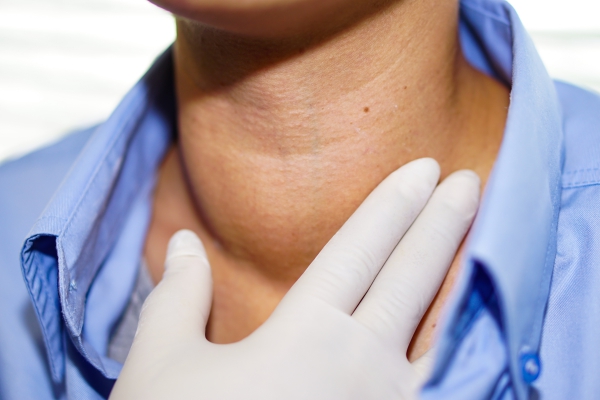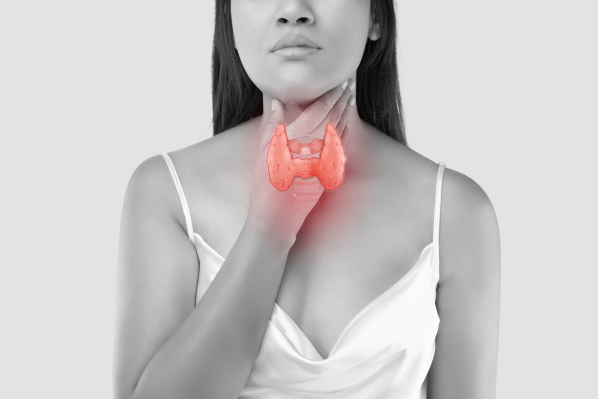What is thyroid cancer?
The thyroid is a butterfly shaped gland that in located in the neck area. It is responsible to release hormones that carry out a variety of functions in the body. Some of these functions include regulation of the heart rate, pressure of blood, body temperature and weight. The hormones produced by the thyroid gland are triiodothyronine, thyroxine and calcitonin. In order to secrete these hormones, the brain has to produce another hormone first, known as the thyroid-stimulating hormone which will stimulate the thyroid gland.
When a cancer develops in the thyroid gland, it may not cause any symptoms at first. However, with time, as the cancer grows and develops, it may start to cause pain and swelling as well as other symptoms. There are several types of thyroid cancers namely: papillary carcinoma, follicular carcinoma, medullary thyroid carcinoma and anaplastic carcinoma amongst others. They vary in their rate of growth and aggressiveness. However, most of them can be cured with treatment and surgery.
Thyroid cancers represent around 1% of all new cancers diagnoses in the United States. Approximately 23,500 cases of thyroid cancers are diagnosed every year. They are usually more common in women compared to men. It is also most common in the 3rd and 4th decades of life.
What are the types of thyroid cancers?
Thyroid cancers are classified based on the type of cells present in the tumour. In order to known which type of tumour a person has, a sample of tissue from the tumour needs to be collected and examined under a microscope. The types of thyroid cancers include the following:

- Papillary thyroid cancer: This is the most common type (80%) and it arises from particular cells known as the follicular cells. It is a type of thyroid cancer that can occur at any age, however, its peak incidence is among people aged between 30-50 years.
- Follicular thyroid cancer: Similarly, follicular cancer also arises from the follicular cells of the thyroid gland. This is most common in older people.
- Anaplastic thyroid cancer: This is the rarest type of cancer affecting the thyroid. However, it is the most aggressive type as it grows rapidly and most often is very difficult to treat.
- Medullary thyroid cancer: This is a type of cancer that affects cells known as C cells that release calcitonin. It is often associated with other diseases as genetic syndromes.
What are the causes of thyroid cancer?
The exact cause of thyroid cancer is not known. A cancer usually arises when cells in an organ or tissue start to multiply uncontrollably due to some underlying genetic mutations that occur in certain cells. The cells lose the ability to die as any other normal cell would do. As the cells continue to grow and multiply, they accumulate forming a tumour. This tumour can further grow and invade surrounding parts of the body.
What are the risk factors for thyroid cancer?

The following factors increases your risk of having thyroid cancer:
- Being a female
- Being exposed to high levels of radiation especially in the head region (as therapies in the cases of other cancers)
- Genetic predispositions
What are the signs and symptoms of thyroid cancer?
When the tumour is at its early stages, there may not be any apparent signs or symptoms. However, with time, the tumour progresses in size and this may result in the appearance of various symptoms. These include:
- Presence of a lump on the neck that can be palpated usually painless
- Hoarseness of voice
- Dysphagia also known as difficulty swallowing
- Neck pain
- Throat pain
- Swollen lymph nodes in the neck
- Heat intolerance
- Palpitations

How is the diagnosis of thyroid cancers made?
To make the diagnosis of thyroid cancers, your doctor will first begin to ask you a series of questions to know more about your symptoms. He/she will then proceed with a full physical examination to look for signs of thyroid cancer. In most cases, your doctor will order further tests to confirm the diagnosis. These include:

- Blood tests: Blood tests can be done to check for the levels of thyroid hormones present in the blood. This is known as thyroid function tests.
- Ultrasound: This is an imaging technique that uses sound waves emitted by a transducer to create images of organs. This allows the identification of nodules in the thyroid gland.
- Biopsy: In this procedure, a sample of the nodule identified is collected using a special needle. This sample is then sent to the laboratory to be examined under the microscope. If cancer cells are identified, the diagnosis of thyroid cancer is confirmed.
How is thyroid cancer treated?
Once the diagnosis is established, your doctor will evaluate the extent of the disease. The cancer will then be staged and treatment initiated accordingly. Treatment options may include the following:
- Watch and wait: If the cancer is very small and has a low risk of spreading to surrounding structure, your doctor may deduce that treatment may not be needed straight away. Instead, he/she will monitor your thyroid with frequent tests. In some cases, the nodule may not progress and never need any kind of treatment. If during surveillance, progression of the disease is noticed, treatment will have to be initiated.
- Surgery: In most cases, surgery is the mainstay of treatment. During the procedure, either all of the thyroid gland may be removed (total thyroidectomy) or only a portion of it (thyroid lobectomy). This will depend on the size and progression of the tumour. In some cases, surrounding lymph nodes may also have to be removed.
- Thyroid hormone therapy: Once the thyroid gland is removed, thyroid hormones need to be administered to compensate for the absent thyroid or else, disturbances will occur in the body. A thyroid hormone medication known as levothyroxine may have to be taken lifelong.
- Radioactive iodine: This is a form of treatment that uses a radioactive substance to destroy microscopic areas of the tumour that may still be present. It also destroys any remaining healthy thyroid tissue. Some possible side effects include the following: dry mouth, mouth pain, eye inflammation, fatigue or a change in the sense of taste or smell.
- Radiation therapy: This is the administration of high energy beams externally through the use of a machine.
- Chemotherapy: In this treatment modality, drugs are administered through your veins to target cancer cells in your thyroid. It may sometimes be used in combination with radiation therapy.

What is the prognosis for thyroid cancer?
98% of people with thyroid cancer live for more than 5 years. However, it strongly depends on the type of cancer as well as the extent of the disease.

Source:
Sharma, P., 2020. Thyroid Cancer.
Yeh MW, Bauer AJ, Bernet VA, et al. American thyroid association statement on preoperative imaging for thyroid cancer surgery. Thyroid. 2015 Jan. 25(1):3-14.
Weir HK, Thompson TD, Soman A, et al. The past, present, and future of cancer incidence in the United States: 1975 through 2020. Cancer. 2015 Feb 3.
Gharib H, Goellner JR. Fine-needle aspiration biopsy of the thyroid: an appraisal. Ann Intern Med. 1993 Feb 15. 118(4):282-9.




